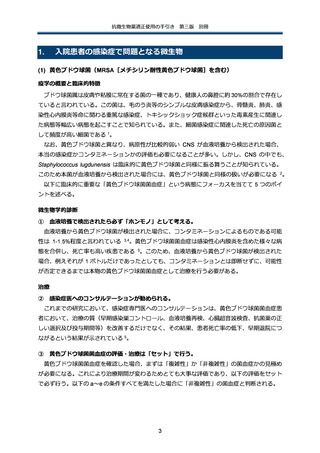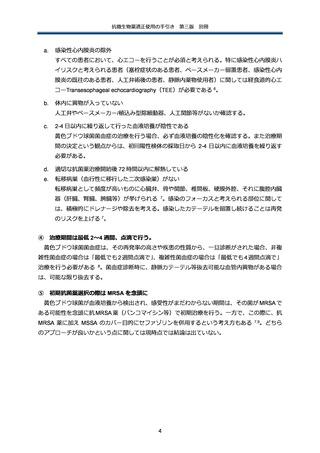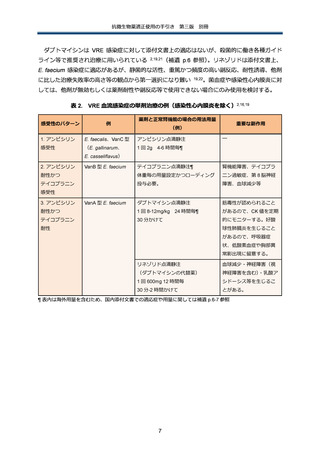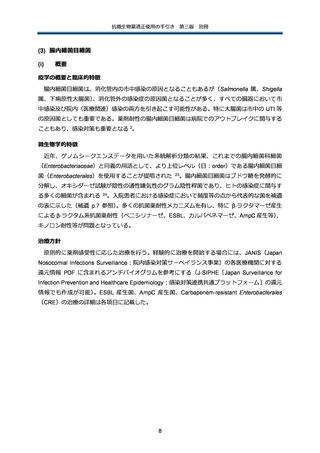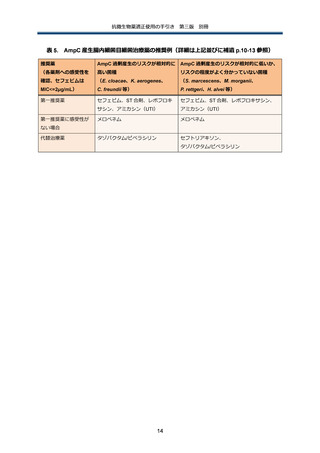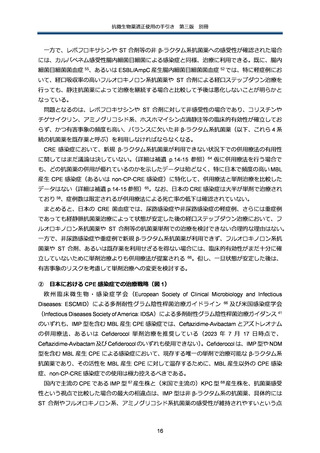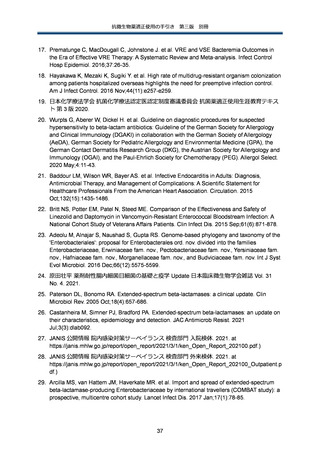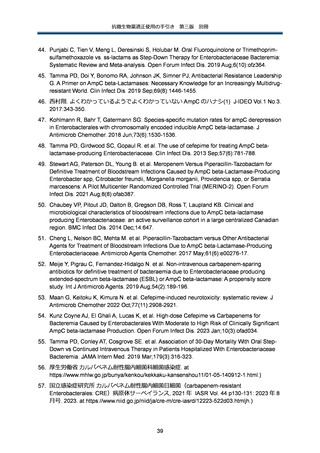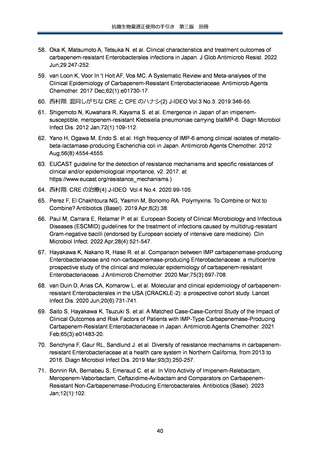よむ、つかう、まなぶ。
【参考資料5】抗微生物薬適正使用の手引き 第三版 別冊 (40 ページ)
出典
| 公開元URL | https://www.mhlw.go.jp/stf/newpage_45318.html |
| 出典情報 | 厚生科学審議会 感染症部会 薬剤耐性(AMR)に関する小委員会 抗微生物薬適正使用(AMS)等に関する作業部会(第6回 11/19)《厚生労働省》 |
ページ画像
ダウンロードした画像を利用する際は「出典情報」を明記してください。
低解像度画像をダウンロード
プレーンテキスト
資料テキストはコンピュータによる自動処理で生成されており、完全に資料と一致しない場合があります。
テキストをコピーしてご利用いただく際は資料と付け合わせてご確認ください。
抗微生物薬適正使用の手引き
第三版
別冊
58. Oka K, Matsumoto A, Tetsuka N. et al. Clinical characteristics and treatment outcomes of
carbapenem-resistant Enterobacterales infections in Japan. J Glob Antimicrob Resist. 2022
Jun;29:247-252.
59. van Loon K, Voor In 't Holt AF, Vos MC. A Systematic Review and Meta-analyses of the
Clinical Epidemiology of Carbapenem-Resistant Enterobacteriaceae. Antimicrob Agents
Chemother. 2017 Dec;62(1):e01730-17.
60. 西村翔. 混同しがちな CRE と CPE のハナシ(2) J-IDEO Vol.3 No.3. 2019:346-55.
61. Shigemoto N, Kuwahara R, Kayama S. et al. Emergence in Japan of an imipenemsusceptible, meropenem-resistant Klebsiella pneumoniae carrying blaIMP-6. Diagn Microbiol
Infect Dis. 2012 Jan;72(1):109-112.
62. Yano H, Ogawa M, Endo S. et al. High frequency of IMP-6 among clinical isolates of metallobeta-lactamase-producing Escherichia coli in Japan. Antimicrob Agents Chemother. 2012
Aug;56(8):4554-4555.
63. EUCAST guideline for the detection of resistance mechanisms and specific resistances of
clinical and/or epidemiological importance, v2. 2017. at
https://www.eucast.org/resistance_mechanisms.)
64. 西村翔. CRE の治療(4) J-IDEO Vol.4 No.4. 2020:99-105.
65. Perez F, El Chakhtoura NG, Yasmin M, Bonomo RA. Polymyxins: To Combine or Not to
Combine? Antibiotics (Basel). 2019 Apr;8(2):38.
66. Paul M, Carrara E, Retamar P. et al. European Society of Clinical Microbiology and Infectious
Diseases (ESCMID) guidelines for the treatment of infections caused by multidrug-resistant
Gram-negative bacilli (endorsed by European society of intensive care medicine). Clin
Microbiol Infect. 2022 Apr;28(4):521-547.
67. Hayakawa K, Nakano R, Hase R. et al. Comparison between IMP carbapenemase-producing
Enterobacteriaceae and non-carbapenemase-producing Enterobacteriaceae: a multicentre
prospective study of the clinical and molecular epidemiology of carbapenem-resistant
Enterobacteriaceae. J Antimicrob Chemother. 2020 Mar;75(3):697-708.
68. van Duin D, Arias CA, Komarow L. et al. Molecular and clinical epidemiology of carbapenemresistant Enterobacterales in the USA (CRACKLE-2): a prospective cohort study. Lancet
Infect Dis. 2020 Jun;20(6):731-741.
69. Saito S, Hayakawa K, Tsuzuki S. et al. A Matched Case-Case-Control Study of the Impact of
Clinical Outcomes and Risk Factors of Patients with IMP-Type Carbapenemase-Producing
Carbapenem-Resistant Enterobacteriaceae in Japan. Antimicrob Agents Chemother. 2021
Feb;65(3):e01483-20.
70. Senchyna F, Gaur RL, Sandlund J. et al. Diversity of resistance mechanisms in carbapenemresistant Enterobacteriaceae at a health care system in Northern California, from 2013 to
2016. Diagn Microbiol Infect Dis. 2019 Mar;93(3):250-257.
71. Bonnin RA, Bernabeu S, Emeraud C. et al. In Vitro Activity of Imipenem-Relebactam,
Meropenem-Vaborbactam, Ceftazidime-Avibactam and Comparators on CarbapenemResistant Non-Carbapenemase-Producing Enterobacterales. Antibiotics (Basel). 2023
Jan;12(1):102.
40
第三版
別冊
58. Oka K, Matsumoto A, Tetsuka N. et al. Clinical characteristics and treatment outcomes of
carbapenem-resistant Enterobacterales infections in Japan. J Glob Antimicrob Resist. 2022
Jun;29:247-252.
59. van Loon K, Voor In 't Holt AF, Vos MC. A Systematic Review and Meta-analyses of the
Clinical Epidemiology of Carbapenem-Resistant Enterobacteriaceae. Antimicrob Agents
Chemother. 2017 Dec;62(1):e01730-17.
60. 西村翔. 混同しがちな CRE と CPE のハナシ(2) J-IDEO Vol.3 No.3. 2019:346-55.
61. Shigemoto N, Kuwahara R, Kayama S. et al. Emergence in Japan of an imipenemsusceptible, meropenem-resistant Klebsiella pneumoniae carrying blaIMP-6. Diagn Microbiol
Infect Dis. 2012 Jan;72(1):109-112.
62. Yano H, Ogawa M, Endo S. et al. High frequency of IMP-6 among clinical isolates of metallobeta-lactamase-producing Escherichia coli in Japan. Antimicrob Agents Chemother. 2012
Aug;56(8):4554-4555.
63. EUCAST guideline for the detection of resistance mechanisms and specific resistances of
clinical and/or epidemiological importance, v2. 2017. at
https://www.eucast.org/resistance_mechanisms.)
64. 西村翔. CRE の治療(4) J-IDEO Vol.4 No.4. 2020:99-105.
65. Perez F, El Chakhtoura NG, Yasmin M, Bonomo RA. Polymyxins: To Combine or Not to
Combine? Antibiotics (Basel). 2019 Apr;8(2):38.
66. Paul M, Carrara E, Retamar P. et al. European Society of Clinical Microbiology and Infectious
Diseases (ESCMID) guidelines for the treatment of infections caused by multidrug-resistant
Gram-negative bacilli (endorsed by European society of intensive care medicine). Clin
Microbiol Infect. 2022 Apr;28(4):521-547.
67. Hayakawa K, Nakano R, Hase R. et al. Comparison between IMP carbapenemase-producing
Enterobacteriaceae and non-carbapenemase-producing Enterobacteriaceae: a multicentre
prospective study of the clinical and molecular epidemiology of carbapenem-resistant
Enterobacteriaceae. J Antimicrob Chemother. 2020 Mar;75(3):697-708.
68. van Duin D, Arias CA, Komarow L. et al. Molecular and clinical epidemiology of carbapenemresistant Enterobacterales in the USA (CRACKLE-2): a prospective cohort study. Lancet
Infect Dis. 2020 Jun;20(6):731-741.
69. Saito S, Hayakawa K, Tsuzuki S. et al. A Matched Case-Case-Control Study of the Impact of
Clinical Outcomes and Risk Factors of Patients with IMP-Type Carbapenemase-Producing
Carbapenem-Resistant Enterobacteriaceae in Japan. Antimicrob Agents Chemother. 2021
Feb;65(3):e01483-20.
70. Senchyna F, Gaur RL, Sandlund J. et al. Diversity of resistance mechanisms in carbapenemresistant Enterobacteriaceae at a health care system in Northern California, from 2013 to
2016. Diagn Microbiol Infect Dis. 2019 Mar;93(3):250-257.
71. Bonnin RA, Bernabeu S, Emeraud C. et al. In Vitro Activity of Imipenem-Relebactam,
Meropenem-Vaborbactam, Ceftazidime-Avibactam and Comparators on CarbapenemResistant Non-Carbapenemase-Producing Enterobacterales. Antibiotics (Basel). 2023
Jan;12(1):102.
40


